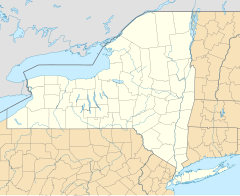Consolidated Edison Company Building
| Consolidated Edison Building | |
|---|---|
 |
|
|
Location within Manhattan
|
|
| General information | |
| Type | Commercial offices |
| Architectural style | Beaux-Arts Neoclassical |
| Location | 4 Irving Place Manhattan, New York 10003 |
| Coordinates | 40°44′03″N 73°59′16″W / 40.7341°N 73.9879°WCoordinates: 40°44′03″N 73°59′16″W / 40.7341°N 73.9879°W |
| Construction started | 1926 |
| Completed | 1928 |
| Owner | Consolidated Edison |
| Height | |
| Roof | 145.7 m (478 ft) |
| Technical details | |
| Floor count | 24 |
| Design and construction | |
| Architect |
Warren and Wetmore Henry Hardenbergh |
| Structural engineer | Thomas E. Murray |
| References | |
| Designated | 2009-02-10 |
| Reference no. | 410 LP-2313 |
The Consolidated Edison Building, also previously known as the Consolidated Gas Building, is a Neoclassical skyscraper built in 1928. Designed by the architectural firms of Warren and Wetmore and Henry Hardenbergh, construction began in 1926 for the future headquarters of Consolidated Edison. The building, located at 4 Irving Place, takes up the entire block between East 14th and 15th Streets and Irving Place and Third Avenue.
Previously, the building's location had been the site of the Academy of Music, New York's third opera house, as well as the original Tammany Hall building. It was originally built for the Consolidated Gas Company, although its predecessor companies, such as the Manhattan Gas Light Company, were located at the same address as early as 1854. On February 10, 2009, the building was declared a National Historic Landmark.
For the structure, the architects worked out a limestone form with its corners clad in mock quoining. Courses of stone were raised to create a column of protruding blocks. The 24-story tower is topped by a "Tower of Light" designed to look like a miniature temple, capped by a bronze lantern which lights up at night. Below the bronze lantern lies a recessed loggia of columns. The columns section is lit up at night with various color themes. Under the column architecture, the tower includes four separate 16-foot wide clock faces on each side of the building.
...
Wikipedia



